Cite this document
(“Marketing to the South Asian Population Assignment”, n.d.)
Marketing to the South Asian Population Assignment. Retrieved from https://studentshare.org/business/1502887-marketing-to-the-south-asian-population
Marketing to the South Asian Population Assignment. Retrieved from https://studentshare.org/business/1502887-marketing-to-the-south-asian-population
(Marketing to the South Asian Population Assignment)
Marketing to the South Asian Population Assignment. https://studentshare.org/business/1502887-marketing-to-the-south-asian-population.
Marketing to the South Asian Population Assignment. https://studentshare.org/business/1502887-marketing-to-the-south-asian-population.
“Marketing to the South Asian Population Assignment”, n.d. https://studentshare.org/business/1502887-marketing-to-the-south-asian-population.


